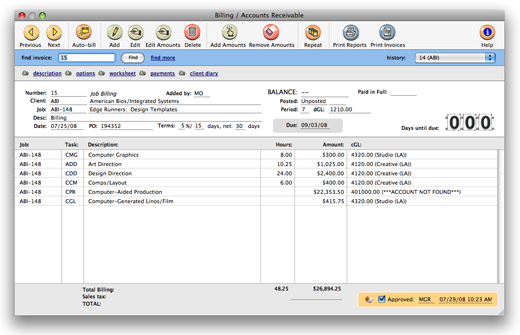Free help: USER GUIDE
Home > Clients & Profits X User Guide > Accounting > Accounts Receivable

|
Clients & Profits X Online User Guide |
Everything you do for a client is billed by adding an invoice into Accounts Receivable.
Clients can be billed for anything
you do -- whether you’re billing an estimate,
an advance, a retainer, a service charge, or a
job’s final costs. A/R invoices are seamlessly
integrated with jobs and costs, so billing is particularly
quick and easy -- and can be mostly automatic.
Every kind of client invoice -- including deposits, retainers, advances,
credits, and discounts -- should be added into Accounts Receivable. Invoices
have one or more line items, which contain the actual billing amounts.
Every task on a job can be billed as a separate line item on an invoice,
providing your clients with a clear, detailed billing -- one that looks
like their estimate. (Click here for more
billing/accounts receivable features.)
To use the Billing/Accounts Receivable window
1 Choose Accounting > Billing/Accounts Receivable.
The Billing/Accounts Receivable window opens, displaying the last added
invoice.

Use the Billing/Accounts Receivable window’s toolbar buttons to
add, edit, edit amounts, delete, and print invoices. Clicking on a button
is the equivalent to choosing a File or Edit menu command.
Click the next or previous buttons to select the next or
previously added invoice. You can find an invoice by entering its invoice
number then clicking the find button. (To search for invoices
by number, sequence, job number, or date click the find more link then follow the prompts.) As you browse from invoice
to invoice, Clients & Profits X keeps track of the last 25 invoices
you've viewed. You can jump back to a previously-displayed invoice using
the history pop-up menu.
For tips on using the Accounts Receivable
window, see the Billing FAQ.
To invoice unbilled job tickets
Clients & Profits X provides an innovative feature that can dramatically
simplify your billing, called auto-billing. Auto-billing creates invoices
automatically for all of your unbilled jobs. It’s the same result
as if you’d entered an invoice for each of your unbilled jobs. Instead,
auto-billing does the work for you. Click here for step-by-step instructions.
To add an invoice
Client billing is based on jobs, tasks, and costs you've posted against
them. Job tickets track everything you spend by task, whether it's time,
buyouts, or out-of-pocket expenses. Click on a link below for step-by-step
instructions:
To edit an invoice
Anything on an unposted invoice can be changed, except the invoice number,
before an invoice is posted. Once an invoice is posted, you can only
change the description and other basic information.
1 From the Accounts Receivable window, find an invoice.
2 Click the edit button.
3 Make your changes, then click Save.
To delete an invoice
Once an invoice is posted, it can’t be deleted -- only adjusted
with credit invoices. Or it can be unposted if it hasn’t been paid
yet.
1 From the Accounts Payable window, find the invoice.
2 Click on the delete button,
or choose Edit > Delete.
Once the invoice is deleted, its number can be used again.
To add, edit or delete billing amounts
Billing line items contain the real details about an invoice. Almost
everything about an invoice line item can be changed until the invoice
is posted. The invoice itself only contains a general description of
the billing, while the line items contain the actual tasks and amounts. Click here for step-by-step instructions.
Credit Invoices
Credit Invoices can be made for a client by entering an invoice with negative billing amounts. When a credit invoice is added as a job billing, the credits will reduce the amount billed on the job ticket; if it's added as a miscellaneous billing, the credit will only affect the client balance. When entering a client payment against a credit invoice, in the payment column of the invoice distribution window enter a negative amount against the negative (credit) invoices. Doing this will net out the client payment to match the amount of the client's check and clear both the normal positive invoices and the credit invoices.
Printing Accounts Receivable Reports
A/R Reports summarize invoices, showing what you've billed to clients,
jobs, and G/L accounts. A/R reports can be used for reporting sales,
tracking billings by client, and auditing your accounting. Click here for step-by-step instructions.
Printing Invoices
Client Invoices can be printed any time after they are posted. Invoices can
be printed individually, or in batches for a range of invoice numbers.
A batch of invoices can also be printed for the same client and a range
of invoice dates; this option lets you print the month’s invoices
for one client quickly and easily. Click here for step-by-step instructions.
To edit an invoice's description
1 From the Accounts Receivable window, find an invoice
then click the description button.
2 Make your changes, then click Save.
To change an invoice's options
1 From the Accounts Receivable window, find an invoice.
2 Click on the Options link.
3 Make your changes, then click Save.
|
|
|
|
|
Learn the proper steps required to prepare and paste your agency logo in invoice preferences so it will appear on printed invoices in this online tutorial. Requires Apple Quicktime 7.0 or greater. Running time: 5:32 |
|
|
|
The Billing Worksheet
Although the job's costs don't actually appear on the invoice, they are
billed when you add an invoice
This means that you’ll always know when vendor invoices, time entries,
checks, and expenses were billed to a client, the amount billed, and
the client’s invoice number. Learn more about the Billing Worksheet here.
The Client Diary/Call Log
The Client Diary/Call Log window lists all of the entries users have
made about interacting with the client, whether it is a phone call or
just a note (a diary entry) about something that is going on. Learn more about the Client Diary here.